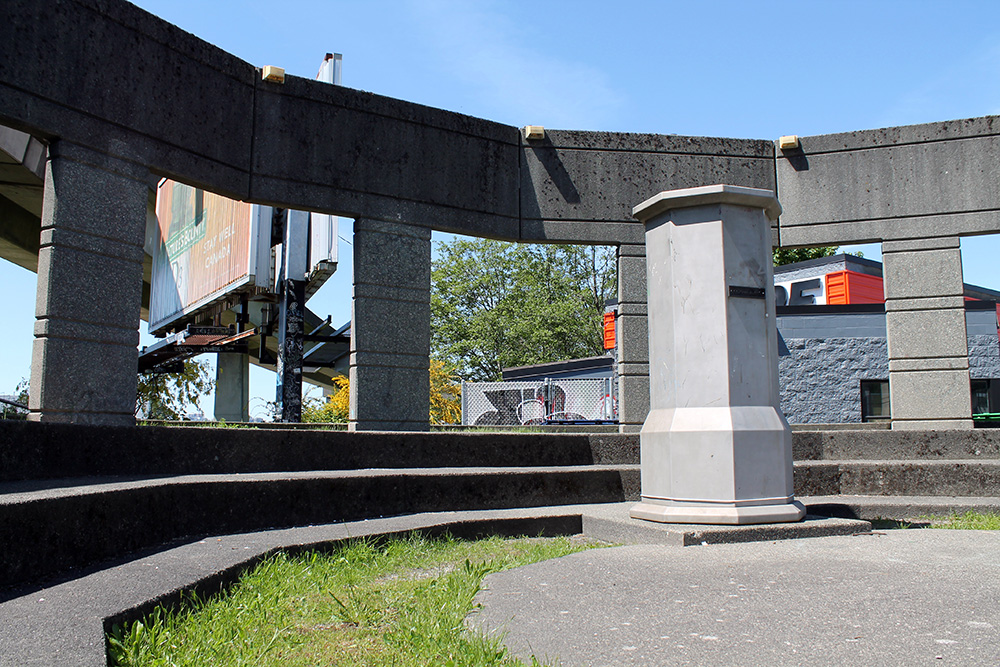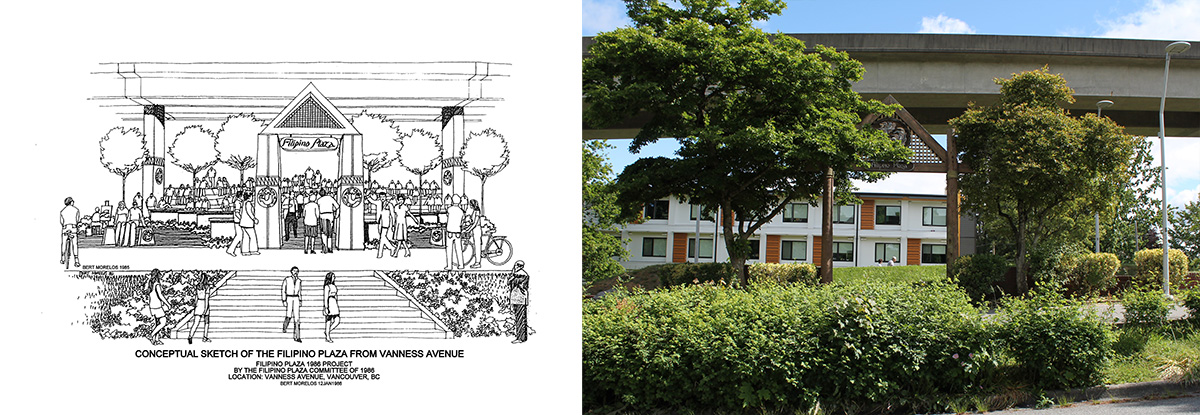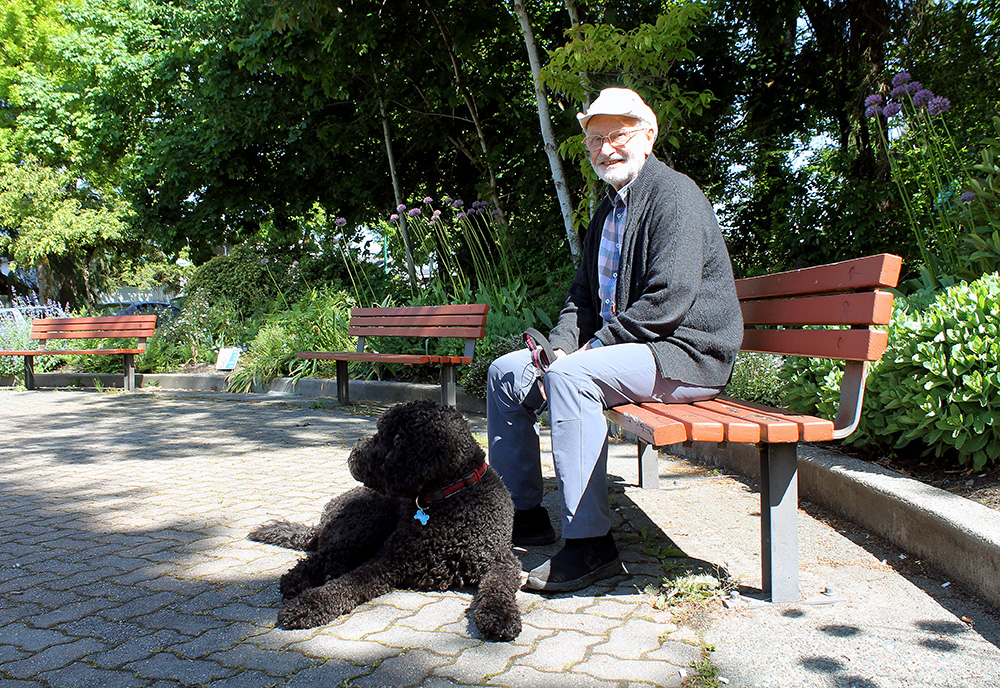As the SkyTrain rushes past at 29th Avenue Station in the busy Renfrew-Collingwood neighbourhood, Artur Luebkemann slows down and takes a moment to appreciate the plaza across the street and remember why it was built.
Surrounding trees offer shade from the sun, and he finds comfort among the garden near his favourite wooden bench. From here, he admires the view of a large brick planter in the middle of the plaza, which bears plaques dedicated to the donors who established it. An antique streetlamp emerges from the bed of ornamental bushes at its centre, with a sign declaring “Deutscher Platz.”
Not everyone will notice these details, but they are a source of pride for Luebkemann, 82, both as a German Canadian and as chairperson for the volunteer committee that founded this German Canadian Heritage Plaza on June 29, 1986.
“Deutscher Platz” is one of several plazas launched 35 years ago for Expo 86, a world’s fair designed to showcase Vancouver and its multicultural makeup on a global stage.
“It’s a symbol,” Luebkemann says.
The idea for the plazas emerged as a way to welcome Expo 86 visitors to Vancouver and its newly-built SkyTrain system.
Grace McCarthy, then B.C.’s minister of transportation, invited cultural groups across Vancouver to sponsor small parks along the BC Parkway, a 26-kilometre path along the SkyTrain’s Expo Line route between Surrey, New Westminster, Burnaby and Vancouver.
The response to McCarthy’s invitation was enthusiastic. One article from a SkyTrain magazine in 1985 boasted partnerships with Vancouver’s Austrian, Dutch, Chinese, Greek and Polish communities for the parks.
Between 18 to 20 plazas in total were planned for the route according to those, like Luebkemann, who were involved with their development.
Leonora Angeles, a professor of social planning at the University of British Columbia, says the plazas offered an opportunity for cultural groups to create “place markers” for their communities.
Place markers are important because they affirm a community’s presence and signify “what a community stands for, and what they value,” says Angeles.
But what does it mean when these place markers disappear?
Today, the German Canadian Heritage Plaza is one of three plazas The Tyee could find information about 35 years after the ambitious Expo 86 initiative. While these three plazas have survived the decades, not all have retained their cultural roots.
This is what happened to Piazza Italia on Clark Drive, says John Teti, a member of the local Italian Canadian association known as the Confratellanza.
The Confratellanza funded the initial development of the plaza, with others contributing materials towards its construction. But Teti believes they wouldn’t be proud of what it’s become now.

Wedged between the SkyTrain tracks at VCC-Clark Station, a tire shop parking lot and six lanes of traffic along Clark Drive, Piazza Italia is difficult to notice and even harder to reach. Those who do will likely be greeted with garbage or graffiti on the concrete pillars encircling the plaza, and the ferocious roar of passing trains from the tracks that loom above it.
An empty pedestal sits in the middle of the plaza, long abandoned by its previous occupant — though it was later briefly home to an unrelated and short-lived guerilla art piece dubbed “Penis Satan.”
The inaccessible and overly industrial location has ultimately deteriorated the plaza’s state too much, leaving Teti with “no affection for it whatsoever.”
Angelo Holmes agrees, even though the space is dedicated to his grandfather Angelo Branca, who was a B.C. Supreme Court judge and leader in Vancouver’s Italian Canadian community.
When the plaza opened on Oct. 11, 1986, it was also meant to be the entrance to a new SkyTrain station on Clark Drive. Holmes, 26 at the time, attended the plaza’s opening with his family. But the station eventually ended up elsewhere and initial promises for that location were abandoned, disappointing Holmes and others.
“They were going to redevelop that area,” says Holmes. “So they anticipated maybe families would be strolling around there, but obviously that didn’t come about, did it?”
Now, the plaza is only a reminder that the space failed to properly represent the Italian community. “We have nothing to do with it. Nothing,” says Holmes.
Even for communities whose plazas have remained in better condition, adequate representation is still an issue.
Near Nanaimo Station, a grand wooden archway welcomes newcomers to a small amphitheatre underneath the tracks. The gate bears the image of a painted bird — its colours slightly dulled, but still visible, which welcomes people to Filipino Plaza.
“Back in the Philippines, in the southern part of the Philippines, the colourful rooster symbolizes wealth and good harvest. They call it Sarimanok,” says Bert Morelos, 74, a member of the original volunteer committee and designer for Filipino Plaza.
Before the plaza opened on April 2, 1986, community members donated bricks to construct the surrounding fence. Each brick cost $25 and is proudly inscribed with the names of the Filipino Canadians who donated them.
But many of these community members had hoped for more beyond the plaza. “When we built it, people then asked, why can’t we follow with a community centre?” says Morelos.
Morelos, an architect in Vancouver since 1974, always wanted to keep his culture close. He designed the Filipino Plaza as a means of providing space for the Filipino community to gather while encouraging the development of a cultural community centre.
But that never happened due to a lack of funding, he says, and a centre in Vancouver is impossible now because of the lack of affordable space. But Morelos says he and the other plaza committee members still dream of creating more someday.

Financial responsibility for the Expo 86 plazas has, since their inception, been left completely to community members. “It’s difficult to raise funds,” says Morelos.
Beatrice Schreiber, president of the German Canadian Business Association and former chair of the committee for the German Canadian Heritage Plaza, agrees.
“Endless hours,” she says. “I worked full time, raised my children, and did these volunteer jobs.”
Beyond the efforts of volunteers from each community, official responsibility for the plazas isn’t clearly centralized anywhere.
Schreiber says they have a contact at the Vancouver Park Board, which eventually took over maintenance for the German Canadian Heritage Plaza a few years ago.
An employee for the park board confirmed that it does maintain the German Canadian Heritage Plaza. According to Morelos, TransLink maintains Filipino Plaza. The responsibility for Piazza Italia, however, is unclear — it may fall somewhere between TransLink and the park board.
In an emailed statement, a TransLink representative wrote that while the transit authority doesn’t own any of the three plazas, it does help to keep two of the plazas clean to “be good neighbours.”
Cleaning is done through the British Columbia Rapid Transit Company upon request at the Filipino Plaza, while staff mows the grass and removes graffiti or garbage as needed at Piazza Italia.
Angeles would like to see public officials increase their commitments to these plazas and recognize the meaning they hold as place markers for these communities.
When we don’t nurture these spaces, Angeles says, “they get neglected, they get bought, they get gentrified, they get covered up, demolished, gone.”
Luebkemann still enjoys taking his dog for regular walks to the German Canadian Heritage Plaza. He checks in on the space when he can, and some of the other volunteers from the plaza committee still do, too.
But he says they are a “skeleton” crew now, as their original members continue to age and retire from their involvement with the plaza. In 2018, the group decided to stop hosting their annual October celebration for German Unity Day at the plaza.
Despite that, Luebkemann says he isn’t worried about the plaza disappearing. Because the area is right next to a park, he doubts it will be abandoned. He is hopeful, though, that others continue to remember its true purpose.
“I hope once my generation is gone that still people enjoy the plaza,” he says. “That there are still some people around who show some interest that the plaza stays in good hands.” ![]()
Read more: Municipal Politics, Urban Planning + Architecture
















Tyee Commenting Guidelines
Comments that violate guidelines risk being deleted, and violations may result in a temporary or permanent user ban. Maintain the spirit of good conversation to stay in the discussion.
*Please note The Tyee is not a forum for spreading misinformation about COVID-19, denying its existence or minimizing its risk to public health.
Do:
Do not: